Acoustics and Aural Perception
While the design of a typical classroom in 2025 will likely include some form of technology, most instruction is still delivered via a live (human) instructor. Speaking and listening remain our primary communication and learning modes. A typical student with normal hearing will spend 60-75% of their day listening, which informs basic concepts on how to speak, read, communicate, and assimilate new information. When outside noise or interior distractions (such as loud mechanical equipment, or noise from activities nearby) interfere with a student’s aural perception, their listening efficiency (measured speech intelligibility accuracy combined with listening effort) is dramatically reduced. High noise levels and excessive reverberation time (RT) have an impact on reading comprehension, auditory and visual attention, short-term memory, behavior, listening fatigue, and social skills in all children.
And what about non-native English language learners? Or students with hearing disadvantages, other disabilities, or learning challenges such as ADHD, cognitive disorders, or autism? Poor acoustics also impact the quality of teaching for instructors. In a loud or excessively reverberant classroom, teachers can experience vocal strain, fatigue and stress.
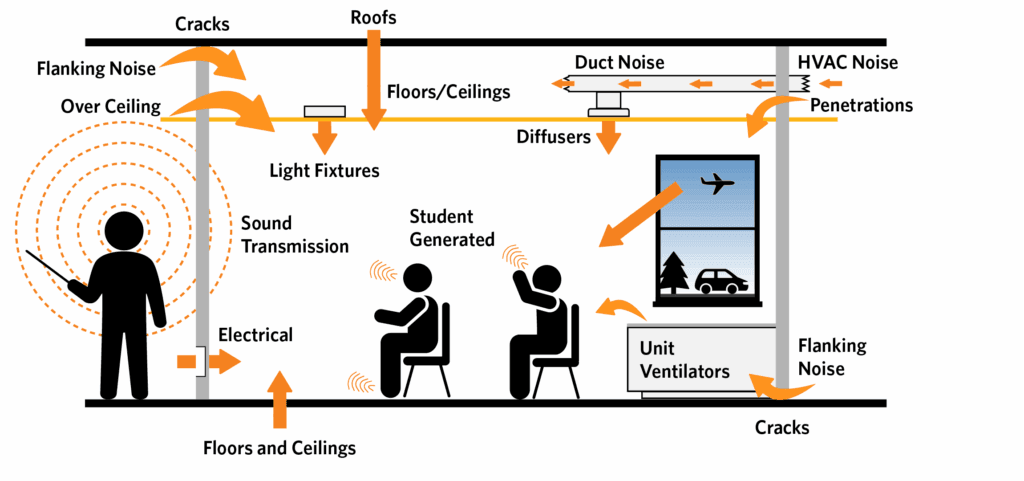
Sarah Oakes, a designer at Perkins Eastman Architects, advocates for good work conditions for teachers when she says,
“Well-designed classrooms can be very impactful on teachers’ vocal health, and help to prevent voice strain if a classroom is designed in such a way that the space doesn’t require the teacher to speak in a raised voice at all times.”
Strategies for Better Acoustics
So, what can we, as acousticians, designers, and stakeholders, do if our classroom is so noisy it interferes with speech intelligibility, making students struggle to understand the instructor (or lose interest altogether)? The good news is that research shows improved classroom acoustics have a significant positive impact on learning for all students, not just students with hearing or learning impairments.
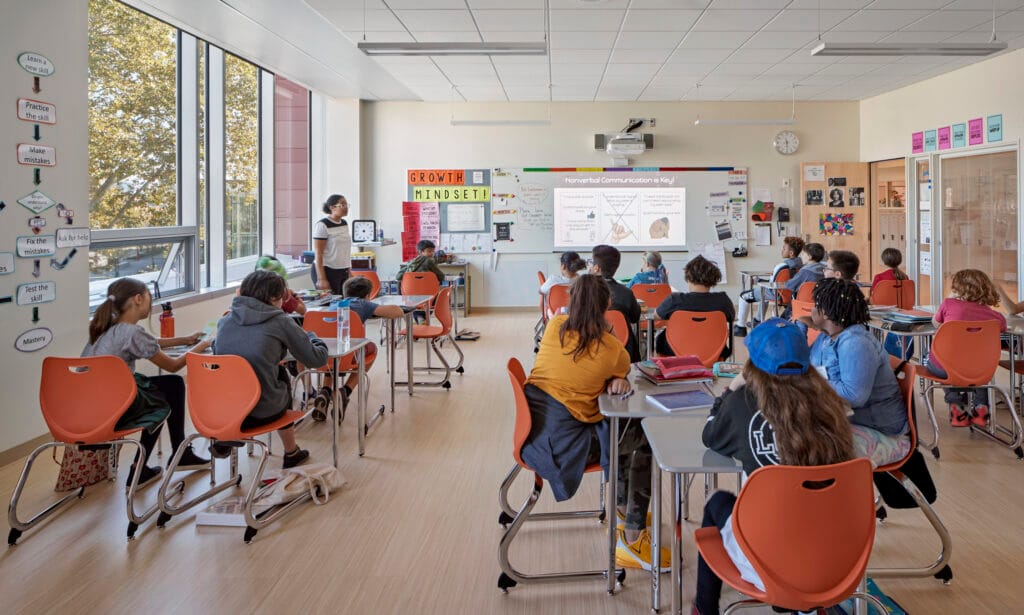
Good listening conditions in a classroom translate into high speech intelligibility. Students should be able to hear and understand words clearly, without strenuous effort. In general, for speech to be intelligible, it should be perceived with sufficient loudness and not be masked by other sounds, whether these are background noise or poorly timed reflections off the room surfaces (meaning delayed copies of the sound itself.)
Another goal is to have a relatively uniform distribution of sound throughout the classroom, so all listeners have an equally intelligible experience. This should account for typical speaking directions of teachers/presenters, and for the directivity of the human voice. The architecture of a room, including size, shaping and finishes, greatly influences speech intelligibility.
3DListening: Hear It For Yourself
This simulation demonstrates the effect of teacher-to-student distance, sound-absorbing finishes, and HVAC noise. The classroom imagined in the simulation is 28 x 30 ft in plan, covering about 800 sq ft. It has a finish ceiling height of 10 ft and encloses a volume of about 8000 cu ft.
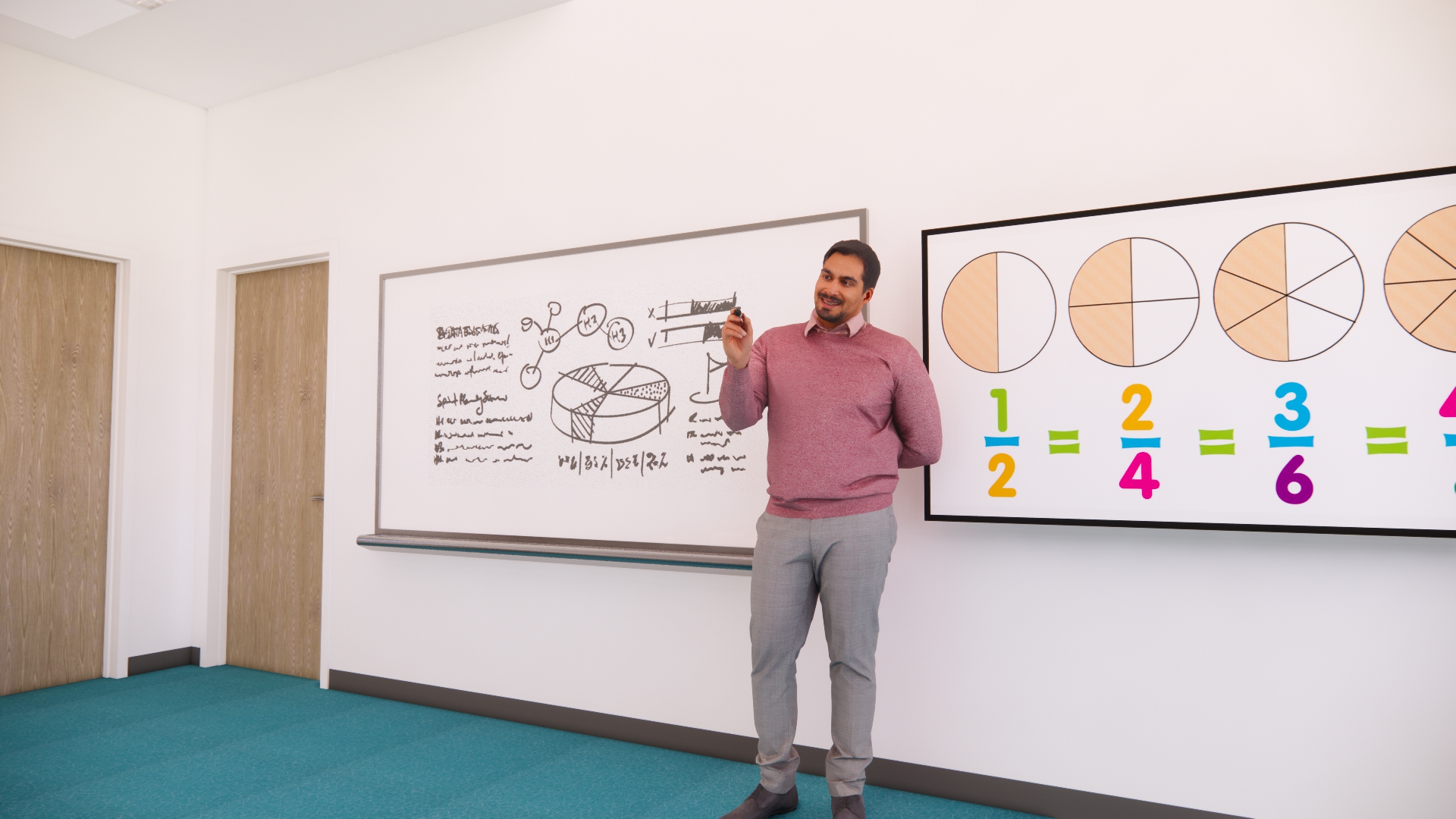
Design Criteria
School representatives are also concerned about noise levels in their classrooms. Carol Harris, a Senior Associate at Jonathan Levi Architects, says,
“When we are hired to design a new school, teachers and administrators will ask, ‘Is this going to be a noisy area?’ They’re particularly concerned about the students with sensory processing differences who need a nice, safe, quiet environment.”
Several architecture-related standards are used as prerequisites for funding public-school projects (such as LEED, CHPS, ICC A117.1, and ANSI 12.602), and they include acoustical requirements – namely, controlling sound build-up and reverberation, mechanical system noise control in classrooms, and sound isolation between adjacent occupied spaces.
Architecture-Related Standards: Explanations
LEED: Leadership in Energy and Environmental Design
A widely used green building certification system that provides a framework for healthy, highly efficient, and cost-saving sustainable buildings. LEED for Schools includes acoustics requirements for controlling reverberation, low exterior noise and low background noise. It includes an extra LEED point for robust constructions and lower background noise. LEED is a requirement for public school funding in some states.
CHPS: Collaborative for High Performance Schools
A program that promotes the design of energy-efficient, healthy, and environmentally responsible school facilities. CHPS includes acoustics requirements for controlling reverberation, robust separating constructions, low exterior noise, and low background noise. CHPS is a requirement for public school construction in some states.
ICC: International Code Council
A standard developed by the International Code Council that specifies technical requirements for making buildings accessible to people with physical disabilities. ICC includes acoustics requirements for controlling reverberation and low background noise. It also indirectly requires robust separating constructions because of its requirement for low intruding noise into classrooms. ICC is required in states that have adopted the 2021 version of the IBC.
ANSI: American National Standards Institute
A standard developed by the Acoustical Society of America that sets minimum acoustical performance criteria for classrooms and other learning spaces, focusing on background noise levels and reverberation to ensure a suitable learning environment. ANSI is no longer a requirement for school building construction but serves as a useful standard for reference including acoustics requirements for controlling reverberation, robust separating constructions, reduced exterior noise, and low interior background noise.
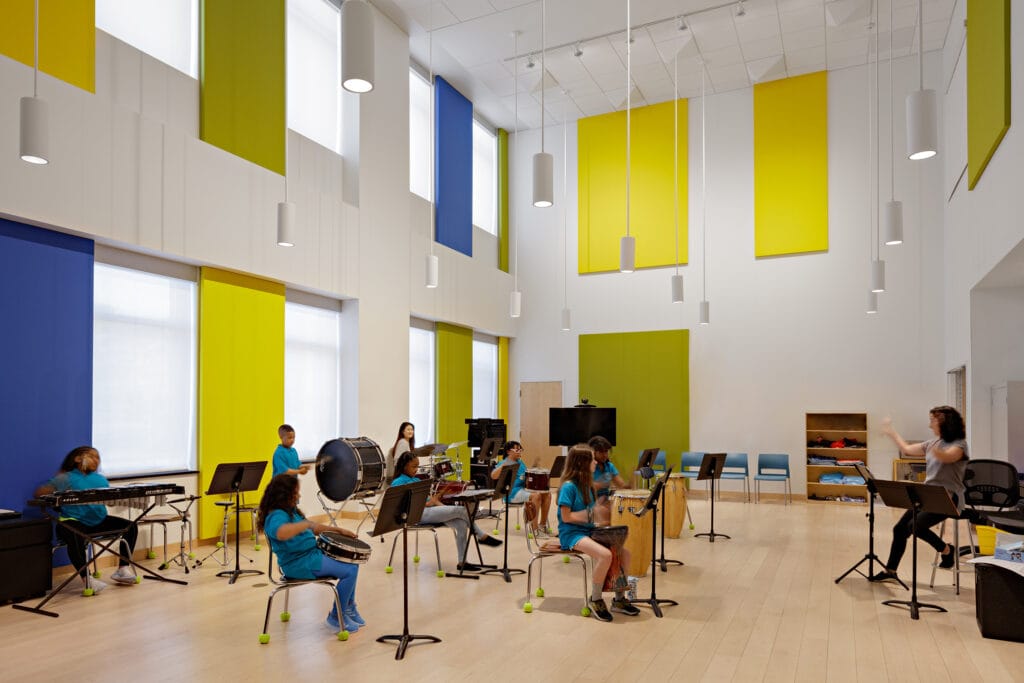
Spaces with good listening conditions are designed to control reverberation and sound build-up. Rooms with hard finishes (windows, glass partitions, wood flooring, and drywall ceilings) experience noise build-up due to multiple sound reflections bouncing off hard surfaces. The reflected sounds layer on each other and compete with the direct sound, making it muddled or unintelligible. By comparison, spaces designed with good listening conditions include sound-absorbing finishes that reduce the energy of sound reflections and minimize the overall sound build-up.
Designers can use sound-absorptive wall and ceiling panels as a strategy to absorb sound. They need to consider several factors such as: how effective is the panel at absorbing sound, what will the panel look like (i.e. will it work with the overall room aesthetics), how much will it cost, and how much panel area is appropriate to balance speech intelligibility with instructor vocal effort.
To that end, Carol Harris says,
“We see designing for better sound as something fun, it’s a challenge. We’re happy to use inexpensive sound treatments in our designs, That’s what we’re here for! We work on patterning or shaping using just simple acoustic panels. It’s all about how you place it. You do it in a thoughtful way, and it turns out really cool. It doesn’t have to be the most expensive thing to be the most interesting thing.”
Specifying quiet mechanical systems is another critical piece of acoustical design, since the noise from those systems can degrade speech intelligibility. In most cases, the challenge of quieting down the background noise levels from the mechanical equipment is a balancing act that takes place during the later phases of the design (typically Design Development and Construction Documents) when the acoustical consultant works closely with the mechanical engineer and the architect to incorporate sound attenuation measures in the ducts paths between equipment and the occupied spaces, as well as vibration isolation control to prevent the equipment from introducing structure-borne vibration into the building.
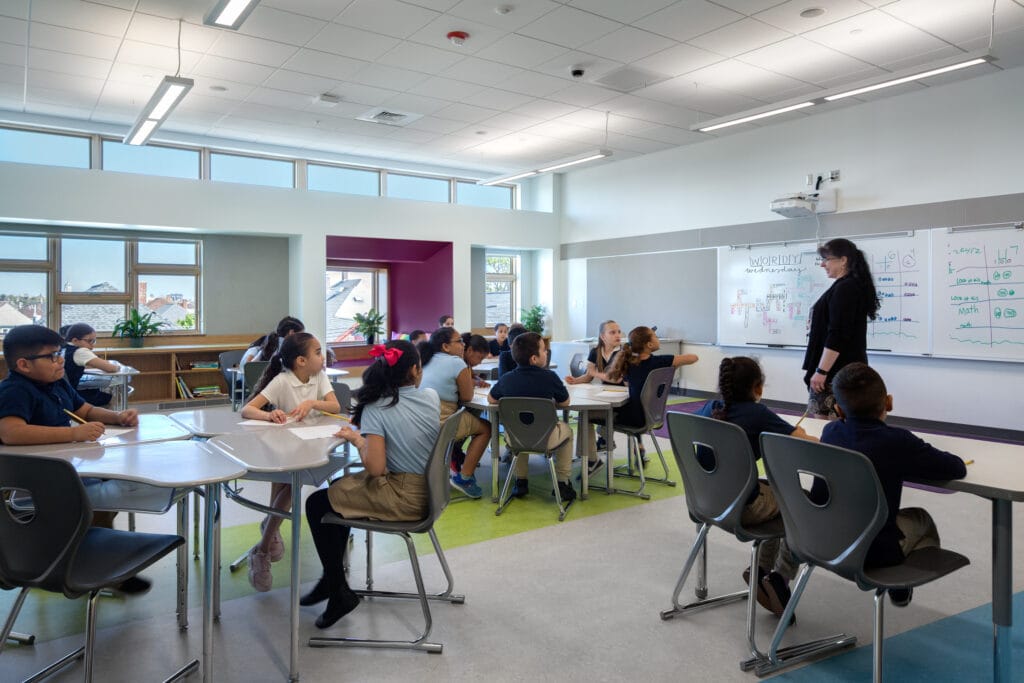
How can we as designers, acousticians, parents, and community members advocate for children, to ensure schools have good listening conditions for all students in their classrooms? When opportunities arise for facility upgrades or new school buildings, we can spread awareness of the importance of good listening conditions in the classroom, be advocates for good acoustical design, and attend town meetings with our local school committees.
“A classroom’s acoustics matter to all of the people who are in the teaching and learning space. An individual’s success rate and overall experience in the classroom is affected by the way sound is relayed and received.”
– Alison Manion, Murdock High School Music Teacher
Proper acoustical design in classrooms is a major part of inclusive design. Understanding more about the importance of good listening conditions, and educating ourselves, our communities and facilities’ stakeholders on the importance of acoustics in learning spaces is just the first step.

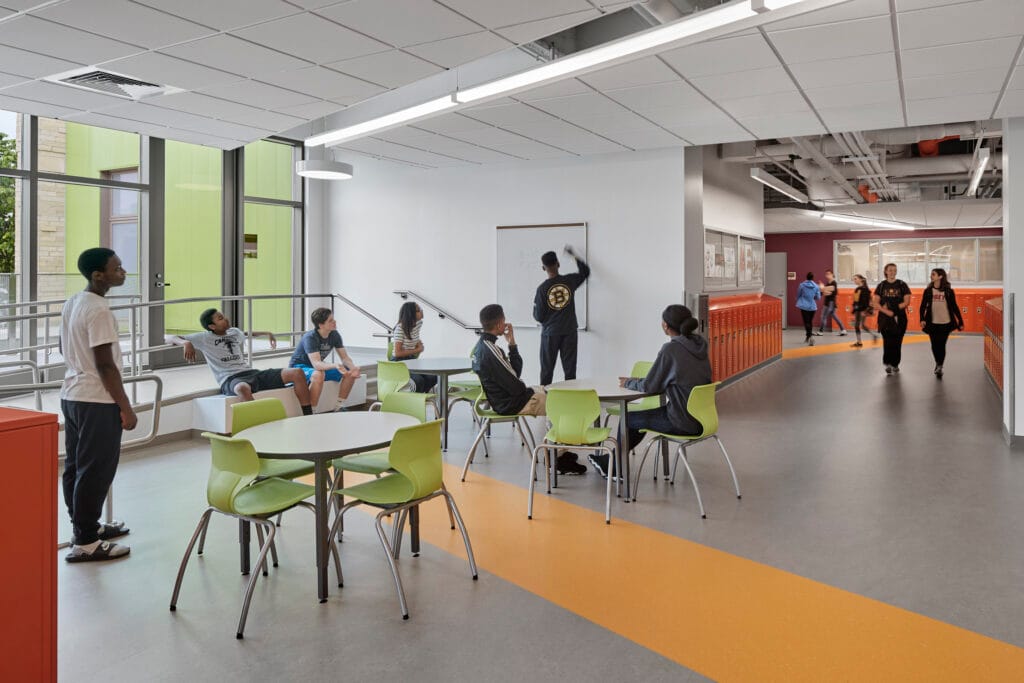
David Harris, Associate at Lavallee Brensinger Architects, puts it succinctly,
“A classroom can be beautiful, but if it doesn’t perform acoustically, it’s not successful.”
